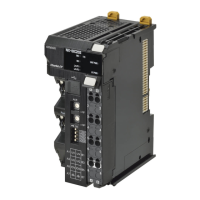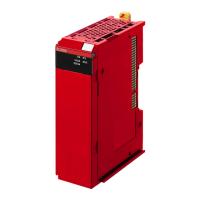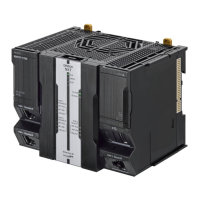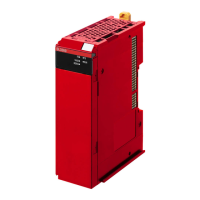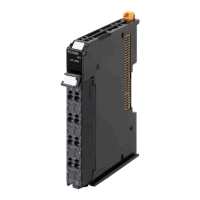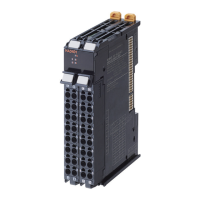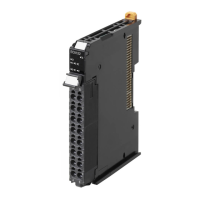

Do you have a question about the Omron NX-EC0112 and is the answer not in the manual?
| Brand | Omron |
|---|---|
| Model | NX-EC0112 |
| Category | Controller |
| Language | English |
Details the personnel for whom this manual is intended, requiring knowledge of electrical systems.
Lists the NX-series Position Interface Units covered in this manual.
Provides referencing lists of data required for configuring systems with NX-series Units.
Explains the page structure and icons used throughout the manual for clarity.
Defines key terms and provides directional context for unit installation within the manual.
Defines key terms and provides directional context for unit installation within the manual.
Details Omron's exclusive warranty, limitations, and the buyer's remedy for product defects.
Explains the notations used for precautions to ensure safe usage of the NX-series Position Interface Unit.
Defines symbols indicating prohibited operations, warnings, general precautions, and required actions.
Details potentially hazardous situations that could result in death, serious injury, or property damage if not avoided.
Highlights precautions for wiring, such as grounding and terminal screw tightening, and online editing.
Instructs to use special packing boxes and avoid excessive vibration or shock during transportation.
Provides instructions for correct installation and wiring, and lists locations to avoid for operation or storage.
Details EC Directives compliance, including installation within a control panel and use of reinforced insulation for power supplies.
Refers to the Instruction Sheet for application conditions when using products complying with UL or CSA standards.
Advises consulting OMRON representative for application conditions related to shipbuilding standards compliance.
Notes that the device is Class A for industrial environments and may cause radio interference in residential areas.
Describes the location and format of unit version information on the product itself.
Explains how to check unit versions of Communications Coupler Unit and NX Units using Sysmac Studio.
Details the relationship between unit versions and Sysmac Studio versions for supported functions and upgrades.
Introduces Position Interface Units, their shared features like screwless clamping terminal blocks, and MC Function Module integration.
Briefly introduces the Position Interface Units and their general capabilities.
Lists and describes the different types of Position Interface Units: Incremental Encoder Input, SSI Input, and Pulse Output Units.
Explains how Position Interface Units operate with an NJ/NX-series Controller and the MC Function Module.
Describes the relationship between Unit functions and CiA402 drive profile functions, focusing on control data.
Explains how to mount NX-series Position Interface Units in an EtherCAT Slave Terminal connected to an EtherCAT master controller.
Details the system configuration for connecting Position Interface Units to an NJ/NX-series CPU Unit via EtherCAT.
Describes the system configuration when connecting Position Interface Units to a controller other than NJ/NX-series via EtherCAT.
Explains the format of model numbers for Position Interface Units, detailing Unit type, channels, and I/O specifications.
Explains the format of model numbers for Position Interface Units, detailing Unit type, channels, and I/O specifications.
Lists the different models of Incremental Encoder Input Units, including channels, inputs, frequency, and I/O mapping.
Lists the different models of SSI Input Units, including channels, inputs, baud rate, and I/O refreshing methods.
Lists the different models of Pulse Output Units, including channels, inputs, outputs, speed, and I/O refreshing methods.
Details functions like counter type setting, encoder count direction, latching, and pulse rate measurement for Incremental Encoder Input Units.
Details functions like counter type setting, encoder count direction, latching, and pulse rate measurement for Incremental Encoder Input Units.
Describes functions for SSI Input Units, including SSI data settings, coding method, error detection, and time stamping.
Explains functions of the Pulse Output Unit, such as pulse output method, output mode selection, and latching.
Lists the support software required for configuring systems with NX-series Position Interface Units based on system configuration.
Lists the support software required for configuring systems with NX-series Position Interface Units based on system configuration.
Explains connecting Sysmac Studio to the CPU Unit or EtherCAT Coupler Unit for system configuration.
Guides on using manufacturer-provided support software for controllers other than NJ/NX-series.
Provides general specifications including enclosure, operating environment, applicable standards, and vibration resistance.
Provides general specifications including enclosure, operating environment, applicable standards, and vibration resistance.
Refers to specific sections for detailed specifications of Incremental Encoder Input Units, SSI Input Units, and Pulse Output Units.
Details basic operating procedures for using Position Interface Units with the MC Function Module in an NJ/NX-series Controller.
Details basic operating procedures for using Position Interface Units with the MC Function Module in an NJ/NX-series Controller.
Describes basic operating procedures for using Position Interface Units without the MC Function Module, relying on basic instructions.
Explains how to use Position Interface Units with an EtherNet/IP Coupler Unit, noting Pulse Output Unit incompatibility.
Provides general guidance for using Position Interface Units with communications networks and controllers from other manufacturers.
Identifies and explains the function of various parts of the Position Interface Units, including connectors and terminal blocks.
Provides information on the indicators present on Position Interface Units, explaining their meaning and status.
Describes the different types of terminal blocks used for easy wiring and removal, and their applicable units.
Details the procedure for mounting two NX Units together, including precautions for handling and connection.
Details the procedure for mounting two NX Units together, including precautions for handling and connection.
Explains how to attach markers to NX Units and terminal blocks for identification, including commercially available options.
Provides instructions on how to remove NX Units, including precautions for handling multiple units and DIN track mounting hooks.
Illustrates the six possible installation orientations for Slave Terminals and mentions restrictions on orientation and specifications.
Describes the two types of power supplies: Unit power supply for Slave Terminal operation and I/O power supply for I/O circuits.
Describes the two types of power supplies: Unit power supply for Slave Terminal operation and I/O power supply for I/O circuits.
Explains how power is supplied to Position Interface Units via NX bus connectors, using Unit and I/O power supplies.
Provides formulas to calculate total I/O current consumption for different Unit types for I/O power supply capacity planning.
Introduces Additional NX Unit Power Supply Unit, Additional I/O Power Supply Unit, and I/O Power Supply Connection Units.
Provides wiring examples for connecting shields to Shield Connection Units (NX-TBX01) for various Unit models.
Details wiring to screwless clamping terminal blocks, including wire types, dimensions, ferrule usage, and connection procedures.
Details wiring to screwless clamping terminal blocks, including wire types, dimensions, ferrule usage, and connection procedures.
Explains how to use Coding Pins to limit Unit and terminal block combinations and prevent incorrect attachment.
Advises on preventing noise-related malfunctions by using correct wire diameters, separating lines, and installing surge absorbers.
Describes methods for checking wiring using Sysmac Studio, MC Test Run, Axis Status Monitor, or I/O Map.
Refers to specific sections for terminal wiring examples for Position Interface Units.
Explains I/O refreshing for NX-series Slave Terminals and operation with built-in EtherCAT port on NJ/NX-series CPU Unit.
Lists I/O refreshing methods for EtherCAT and EtherNet/IP Coupler Units: Free-Run, Synchronous, and Task Period Prioritized.
Lists I/O refreshing methods for EtherCAT and EtherNet/IP Coupler Units: Free-Run, Synchronous, and Task Period Prioritized.
Describes how to set the I/O refreshing method for each Communications Coupler Unit.
Explains the operation of Free-Run, Synchronous, and Task Period Prioritized refreshing methods.
Explains how to interpret model numbers of Incremental Encoder Input Units, detailing Unit type, channels, and specifications.
Shows the system configuration of an Incremental Encoder Input Unit, including support software and connections.
Details the process flow for using an Incremental Encoder Input Unit with the MC Function Module.
Details the process flow for using an Incremental Encoder Input Unit with the MC Function Module.
Outlines the process flow for using an Incremental Encoder Input Unit without the MC Function Module, relying on basic instructions.
Identifies and explains the parts of Incremental Encoder Input Units with voltage and line receiver inputs.
Identifies and explains the parts of Incremental Encoder Input Units with voltage and line receiver inputs.
Describes the functions of Unit Hookup Guides, Indicators, Terminal Blocks, and NX Bus Connectors for Incremental Encoder Input Units.
Explains the indicators on Incremental Encoder Input Units (NX-EC0112, NX-EC0122, NX-EC0132, NX-EC0142, NX-EC0212, NX-EC0222) and their meanings.
Shows the terminal block arrangement and internal power supply wiring for the NX-EC0112 unit.
Shows the terminal block arrangement and internal power supply wiring for the NX-EC0112 unit.
Provides diagrams of the terminal block arrangement and internal power supply wiring for the NX-EC0122 unit.
Details the terminal block arrangement and internal power supply wiring for the NX-EC0132 unit.
Presents diagrams of the terminal block arrangement and internal power supply wiring for the NX-EC0142 unit.
Shows the terminal block arrangement and internal power supply wiring for the NX-EC0212 unit.
Provides diagrams of the terminal block arrangement and internal power supply wiring for the NX-EC0222 unit.
Explains how to set I/O refreshing methods for Incremental Encoder Input Units based on EtherCAT Coupler Unit settings.
Explains how to set I/O refreshing methods for Incremental Encoder Input Units based on EtherCAT Coupler Unit settings.
Describes the Free-Run refreshing method for exchanging data without worrying about timing.
Explains synchronous I/O refreshing to synchronize data timing for multiple SSI Input Units with controller processing.
Details task period prioritized refreshing, prioritizing task period shortening over I/O timing synchronization.
Compares I/O refreshing methods, parameter settings, and functions based on the connected controller type.
Lists data items that can be allocated to I/O for One-input and Two-input Incremental Encoder Units.
Lists data items that can be allocated to I/O for One-input and Two-input Incremental Encoder Units.
Describes data configurations for Encoder Counter Status, Reset/External Input Status, and Encoder Present Position.
Guides on axis parameters and assigning axis variables when using Incremental Encoder Input Units as encoder axes with MC Function Module.
Explains mounting Incremental Encoder Input Units after an EtherCAT Coupler Unit and connecting to external devices.
Explains mounting Incremental Encoder Input Units after an EtherCAT Coupler Unit and connecting to external devices.
Lists the functional specifications of the Incremental Encoder Input Unit, including counter range and speed.
Provides minimum parameter settings for Incremental Encoder Input Units with the MC Function Module, covering output methods and signals.
Details functions like counter type setting, encoder count direction, latching, and pulse rate measurement for Incremental Encoder Input Units.
Lists parameters for Incremental Encoder Input Units, including external input, counter type, and pulse input methods.
Explains how to use the Counter Type parameter to set the counter mode to ring or linear counter.
Details the three pulse input methods: phase differential pulse, pulse + direction, and up and down pulses.
Explains how to set the encoder direction for each counter to specify increment/decrement direction.
Describes how to specify gate control for each counter to enable or disable counting.
Explains the three reset methods: internal reset, external input reset, and phase-Z input reset.
Details how to preset a value using the Preset Command Value parameter and the Preset Execution bit.
Explains the two latch methods: internal latch execution and external input latch trigger.
Describes how to use external inputs for general input, gate, reset, or latch inputs, noting model limitations.
Explains how to measure input pulses in a specified time window to calculate pulse frequency and rotation rate.
Describes how to measure the period between rising or falling edges of the input pulse for phase-A input pulses.
Explains how to obtain DC time when position data changes, used for I/O controls based on time stamps.
Provides general specifications for Incremental Encoder Input Units, including I/O interface, channels, input signals, and power consumption.
Provides general specifications for Incremental Encoder Input Units, including I/O interface, channels, input signals, and power consumption.
Details pulse input specifications for voltage input and line receiver input types, including voltage, current, and frequency.
Lists the specifications for external inputs, including voltage, current, and response times.
Explains how to interpret model numbers for SSI Input Units, covering Unit type, channels, and specifications.
Illustrates the system configuration for an SSI Input Unit, including connections to controllers and encoders.
Details the process flow for using an SSI Input Unit with the MC Function Module in an NJ/NX-series Controller.
Details the process flow for using an SSI Input Unit with the MC Function Module in an NJ/NX-series Controller.
Outlines the process flow for using an SSI Input Unit without the MC Function Module, relying on basic instructions.
Identifies and explains the parts of SSI Input Units, including connectors, indicators, and terminal blocks.
Identifies and explains the parts of SSI Input Units, including connectors, indicators, and terminal blocks.
Describes the functions of Unit Hookup Guides, Indicators, Terminal Blocks, and NX Bus Connectors for SSI Input Units.
Explains the indicators on SSI Input Units (NX-ECS112, NX-ECS212) and their meanings for status and communications.
Shows the terminal block arrangement and internal power supply wiring for the NX-ECS112 SSI Input Unit.
Shows the terminal block arrangement and internal power supply wiring for the NX-ECS112 SSI Input Unit.
Details the terminal block arrangement and internal power supply wiring for the NX-ECS212 SSI Input Unit.
Explains how to set I/O refreshing methods for SSI Input Units based on EtherCAT Coupler Unit settings.
Explains how to set I/O refreshing methods for SSI Input Units based on EtherCAT Coupler Unit settings.
Describes Free-Run refreshing for SSI Input Units, which exchanges data asynchronously with the controller.
Explains synchronous I/O refreshing to synchronize SSI data timing with controller processing.
Details task period prioritized refreshing for SSI Input Units, prioritizing task period over I/O timing synchronization.
Compares I/O refreshing methods, parameter settings, and functions based on the connected controller type.
Describes the status of data exchange between the controller and SSI Input Unit, including normal and error conditions.
Lists data items that can be allocated to I/O for One-input and Two-input SSI Units.
Lists data items that can be allocated to I/O for One-input and Two-input SSI Units.
Describes data configurations for SSI Status, SSI Communications Error Code, Encoder Present Position, and Status Data.
Guides on axis parameters and assigning axis variables for SSI Input Units used as encoder axes with MC Function Module.
Explains mounting SSI Input Units after an EtherCAT Coupler Unit and connecting to SSI encoders.
Explains mounting SSI Input Units after an EtherCAT Coupler Unit and connecting to SSI encoders.
Provides minimum parameter settings for SSI Input Units with the MC Function Module, covering communications and count direction.
Details functions like counter type setting, encoder count direction, latching, and pulse rate measurement for Incremental Encoder Input Units.
Lists parameters for SSI Input Units, including Baud Rate, SSI communications startup time, and parity check settings.
Explains how to set bit positions and lengths for multi-turn, single-turn, and status data for various SSI encoder formats.
Details methods for converting SSI data: No Change, Output Binary Codes, Change Gray Codes to Binary, and Change Binary/Gray Codes to Present Values.
Explains how to change the count direction of data received from the encoder.
Describes how to shift the first bit in received frames to specify the first position of received SSI data.
Explains parity checks performed on SSI data bits and how errors are reflected in the SSI Status parameter.
Describes methods to check data refresh status using Data Refresh Status bit or Encoder Present Position Refresh Count.
Explains how to separate error data based on position variation limits, discarding data and not refreshing position.
Describes how to obtain DC time when position data changes, used for I/O controls based on time stamps.
Provides general specifications for SSI Input Units, including I/O interface, channels, data length, and power consumption.
Explains how to interpret model numbers of Pulse Output Units, detailing Unit type, channels, and specifications.
Illustrates the system configuration of a Pulse Output Unit, including connections to controllers, drives, and motors.
Describes the control states and transitions for Pulse Operation Unit operations, controlled by Controlword and Statusword.
Describes the control states and transitions for Pulse Operation Unit operations, controlled by Controlword and Statusword.
Outlines motor control in Cyclic Synchronous Position Control Mode, sending target positions and monitoring actual values.
Details the process flow for using a Pulse Output Unit with the MC Function Module.
Details the process flow for using a Pulse Output Unit with the MC Function Module.
Outlines the process flow for using a Pulse Output Unit without the MC Function Module, requiring user program control.
Identifies and explains the parts of Pulse Output Units, including connectors, indicators, and terminal blocks.
Identifies and explains the parts of Pulse Output Units, including connectors, indicators, and terminal blocks.
Describes the functions of Unit Hookup Guides, Indicators, Terminal Blocks, and NX Bus Connectors for Pulse Output Units.
Explains the indicators on Pulse Output Units (NX-PG0112, NX-PG0122) and their meanings for status and operation.
Shows the terminal block arrangement and internal power supply wiring for the NX-PG0112 Pulse Output Unit.
Shows the terminal block arrangement and internal power supply wiring for the NX-PG0112 Pulse Output Unit.
Provides diagrams of the terminal block arrangement and internal power supply wiring for the NX-PG0122 Pulse Output Unit.
Explains how to set I/O refreshing methods for Pulse Output Units based on EtherCAT Coupler Unit settings.
Explains how to set I/O refreshing methods for Pulse Output Units based on EtherCAT Coupler Unit settings.
Describes synchronous I/O refreshing to match Controller and Unit pulse output timing.
Details task period prioritized refreshing for Pulse Output Units, prioritizing task period over I/O timing synchronization.
Compares I/O refreshing methods, parameter settings, and functions based on the connected controller type.
Lists data items that can be allocated to I/O for a Pulse Output Unit, including input and output data.
Lists data items that can be allocated to I/O for a Pulse Output Unit, including input and output data.
Describes data configurations for Statusword, External Input Status, Command Position, and Controlword.
Explains mounting Pulse Output Units after an EtherCAT Coupler Unit and connecting to external devices.
Explains mounting Pulse Output Units after an EtherCAT Coupler Unit and connecting to external devices.
Highlights differences in functions and operation when using Pulse Output Units compared to G5-series Servo Drives.
Provides minimum parameter settings for Pulse Output Unit with MC Function Module, covering output methods and signals.
Lists parameters for Pulse Output Units, including pulse output method, output mode selection, and external I/O settings.
Lists parameters for Pulse Output Units, including pulse output method, output mode selection, and external I/O settings.
Explains the two pulse output methods: Forward/Reverse Direction Pulse and Pulse + Direction.
Details Position-synchronous and Velocity-continuous pulse output modes for servomotor and stepping motor control.
Describes the single external output port, which can be used as an error counter reset output or a general output.
Explains how to use external inputs as latch inputs for capturing present position, detailing trigger conditions and modes.
Describes setting external inputs for general input, latch input, gate, or reset, and their logic selection.
Allows stopping pulse output via immediate stop or deceleration stop with set deceleration rate when errors occur.
Explains interpolation for missing synchronization commands, presuming position and velocity based on previous data.
Specifies wait time for reverse direction pulse signals when changing pulse output to reverse operation.
Provides general specifications for Pulse Output Units, including channels, output speed, control range, and power consumption.
Provides general specifications for Pulse Output Units, including channels, output speed, control range, and power consumption.
Details pulse output specifications and waveforms for NPN and PNP output units, including ON/OFF widths.
Lists specifications for external inputs and outputs of the Pulse Output Unit, including voltage, current, and response times.
Provides a system configuration, setting, and programming example for a possible case scenario.
Describes the example system configuration for implementing control with an NJ-series Controller, EtherCAT Coupler, and Position Interface Units.
Describes the example system configuration for implementing control with an NJ-series Controller, EtherCAT Coupler, and Position Interface Units.
Illustrates the wiring example for an OMRON G5-series Servo Drive and Servomotor with Pulse Output Unit and Digital I/O Units.
Details creating a new project and building the EtherCAT network and Slave Terminal configuration in Sysmac Studio.
Details creating a new project and building the EtherCAT network and Slave Terminal configuration in Sysmac Studio.
Describes minimum parameter settings for the Pulse Output Unit using MC Function Module in an NJ-series Controller.
Explains assigning inputs/outputs from Pulse Output and Digital I/O Units to MC Function Module axes and device variables.
Guides on setting MC Function Module functions according to the required control type and procedures.
Lists and describes the main variables used in the ladder programming example for relative positioning.
Lists and describes the main variables used in the ladder programming example for relative positioning.
Provides a ladder programming example for relative positioning, illustrating interlocks and control logic.
Outlines methods for checking errors, including checking indicators and using Sysmac Studio troubleshooting functions.
Explains how to use TS indicators on NX Units to check Unit status and errors, and provides main error causes and corrections.
Describes how to check current and past errors using Sysmac Studio's Controller Error Tab Page and Event Log Tab Page.
Describes how to check current and past errors using Sysmac Studio's Controller Error Tab Page and Event Log Tab Page.
Lists and explains various errors (events) that can occur in Position Interface Units, including event codes, meanings, causes, and corrections.
Refers to the connected Communications Coupler Unit's user manual for information on resetting errors.
Provides troubleshooting for common errors in Incremental Encoder Input Units, such as no count pulses detected or incorrect counting.
Provides troubleshooting for common errors in Incremental Encoder Input Units, such as no count pulses detected or incorrect counting.
Lists common errors and possible corrections for SSI Input Units, including issues with data refreshing and settings.
Details errors and possible corrections for Pulse Output Units, covering issues like no pulse output, incorrect pulse output, and no external output.
Refers to the connected Communications Coupler Unit's manual for the standard troubleshooting flow.
Provides procedures for cleaning Position Interface Units using soft cloths, with precautions against solvents and touching the NX bus connector.
Provides procedures for cleaning Position Interface Units using soft cloths, with precautions against solvents and touching the NX bus connector.
Recommends periodic inspections (every six months to a year) for components like power supplies and I/O to ensure optimal operating condition.
Instructs to follow the connected Communications Coupler Unit's manual for procedures to replace a Position Interface Unit.
Provides a summary table of models for Incremental Encoder Input, SSI Input, and Pulse Output Units with key specifications.
Provides a summary table of models for Incremental Encoder Input, SSI Input, and Pulse Output Units with key specifications.
Describes how to interpret datasheets for Incremental Encoder Input Units, covering specifications like channels, input voltage, and frequency.
Explains how to interpret datasheets for SSI Input Units, including unit name, channels, I/O signals, and transmission distance.
Details how to interpret datasheets for Pulse Output Units, covering specifications for pulse outputs and external I/O.
Defines the format used to describe objects, including index, subindex, object name, default value, data range, and access.
Defines the format used to describe objects, including index, subindex, object name, default value, data range, and access.
Lists product information objects, I/O allocation objects, and message communications objects for Incremental Encoder Input Units.
Provides product information, I/O allocation, and message communications objects for SSI Input Units.
Lists product information objects, I/O allocation objects, and message communications objects for Pulse Output Units.
Provides dimensional information in millimeters for various Position Interface Units.
Explains the format of terminal block model numbers.
Explains the format of terminal block model numbers.
Lists the terminal blocks and their applicable units, including number of terminals and current capacity.
Describes compatibility between versions of Position Interface Units, Coupler Units, CPU Units, and Sysmac Studio.
Describes compatibility between versions of Position Interface Units, Coupler Units, CPU Units, and Sysmac Studio.
Explains how to interpret version combination tables for NX Units and their corresponding software/hardware versions.
Provides tables showing version compatibility for NX Units with EtherCAT and EtherNet/IP Coupler Units, CPU Units, and Sysmac Studio.
Defines the format used to describe motion control instructions, including attributes and applicability.
Defines the format used to describe motion control instructions, including attributes and applicability.
Lists common commands implemented by instructions not related to the presence of a Pulse Output Unit.
Details instructions for axis commands such as Power Servo, Jog, Home, and Positioning.
Lists instructions for axes group commands, including Enable Axes Group, Linear Interpolation, and Group Stop.




